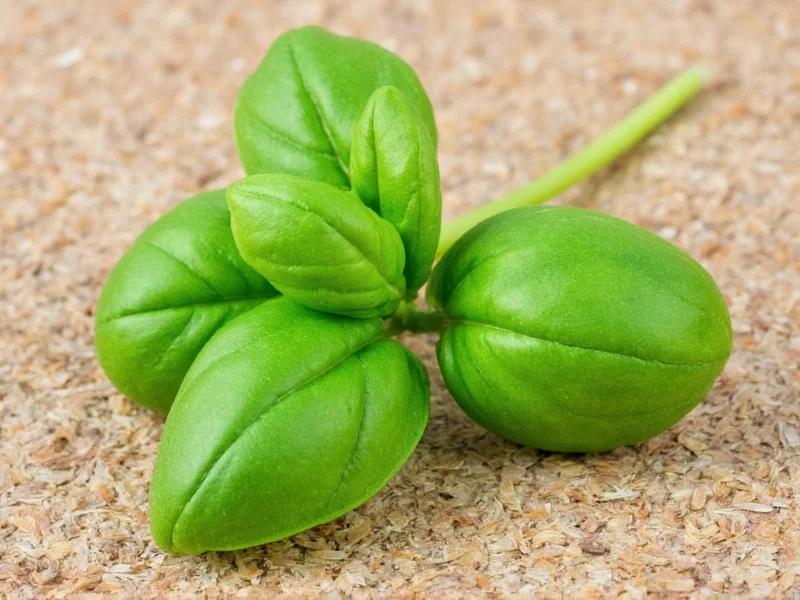The dry equivalent of fresh basil is a 3:1 ratio—meaning 1 tablespoon of fresh basil equals 1 teaspoon of dried basil. This conversion accounts for the concentrated flavor in dried herbs due to moisture removal during the drying process.
Understanding herb conversions is essential for consistent cooking results. When substituting dried basil for fresh in recipes, this standard ratio ensures your dishes maintain balanced flavor without becoming overpowering. The concentration occurs because drying removes approximately 90% of the moisture content, intensifying the essential oils that carry basil's distinctive taste.
Why the 3:1 Ratio Matters in Cooking
Fresh basil contains significant water content that dilutes its flavor compounds. When dried, these compounds become more concentrated. Using equal measurements would result in dried basil overwhelming your dish. Professional chefs and recipe developers consistently apply this ratio to maintain recipe integrity across different herb forms.
Flavor Profile Differences Between Fresh and Dried Basil
While the conversion ratio addresses quantity, understanding flavor differences is equally important. Fresh basil offers bright, sweet notes with subtle peppery undertones and a delicate aroma. Dried basil develops deeper, more earthy characteristics with slightly muted sweetness. The drying process alters volatile compounds, creating a more robust but less complex flavor profile.
| Characteristic | Fresh Basil | Dried Basil |
|---|---|---|
| Flavor Intensity | Mild | Concentrated (3x stronger) |
| Aroma Profile | Bright, sweet, peppery | Earthy, deeper notes |
| Best Used In | Finishing dishes, salads, pesto | Long-cooking sauces, soups, stews |
| Shelf Life | 5-7 days refrigerated | 2-3 years stored properly |
Practical Substitution Guidelines
When converting recipes that call for fresh basil to use dried instead, follow these professional kitchen standards:
- For every 1 tablespoon fresh basil, use 1 teaspoon dried basil
- For every 1 cup fresh basil, use 1/3 cup dried basil
- Add dried basil earlier in cooking to allow rehydration and flavor dispersion
- Reduce dried basil by 25% when substituting in delicate dishes like salads or garnishes
Optimizing Dried Basil Usage in Recipes
Dried basil performs best when incorporated into dishes with sufficient liquid and cooking time. The rehydration process unlocks maximum flavor potential. For tomato-based sauces, add dried basil during the simmering phase—typically 15-20 minutes before completion. In dry rubs or bread doughs, mix dried basil with other dry ingredients first to ensure even distribution.
Chef's tip: Bloom dried basil in warm olive oil for 2-3 minutes before adding to recipes. This technique releases essential oils more effectively than direct addition to liquids, creating a more pronounced flavor profile that better approximates fresh basil's vibrancy.
Storage Best Practices for Maximum Flavor Retention
Proper storage significantly impacts dried basil's potency. Keep dried basil in an airtight container away from light, heat, and moisture. The ideal storage temperature is below 70°F (21°C). When stored correctly, dried basil maintains optimal flavor for 18-24 months. Test potency by rubbing a small amount between your fingers—if the aroma is weak, it's time to replace your supply.
Common Substitution Mistakes to Avoid
Cooks often make these errors when substituting dried for fresh basil:
- Using equal measurements instead of adjusting for concentration
- Adding dried basil too late in the cooking process
- Using old, stale dried basil that has lost potency
- Not accounting for recipe moisture content when converting
Remember that acidic ingredients like tomatoes or vinegar can accelerate flavor degradation in dried herbs. When making tomato sauces, add dried basil after the tomatoes have cooked for 10-15 minutes to preserve its flavor compounds.
When Fresh Basil Is Irreplaceable
While dried basil works well in cooked dishes, certain applications demand fresh. Caprese salad, fresh pesto, and garnishes benefit from fresh basil's vibrant color and delicate texture that dried basil cannot replicate. For these dishes, seek alternatives like frozen basil cubes if fresh isn't available rather than forcing a dried substitution.
Measuring Techniques for Precision
Accurate measurement matters when converting between fresh and dried basil. When measuring fresh basil, lightly pack leaves into the spoon without compressing. For dried basil, spoon gently into the measuring tool then level with a straight edge—don't pack unless the recipe specifically instructs. A kitchen scale provides the most precise conversion: 3 grams fresh basil equals approximately 1 gram dried basil.











 浙公网安备
33010002000092号
浙公网安备
33010002000092号 浙B2-20120091-4
浙B2-20120091-4